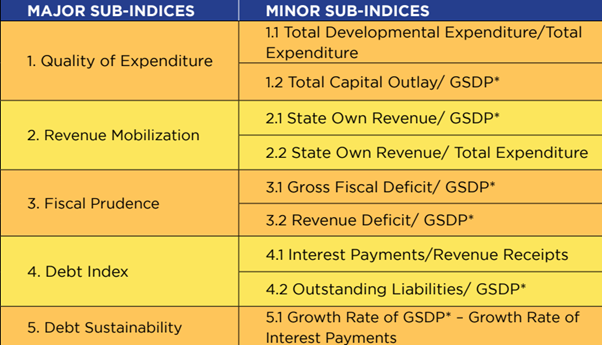- Courses
- GS Full Course 1 Year
- GS Full Course 2 Year
- GS Full Course 3 Year
- GS Full Course Till Selection
- Answer Alpha: Mains 2025 Mentorship
- MEP (Mains Enrichment Programme) Data, Facts
- Essay Target – 150+ Marks
- Online Program
- GS Recorded Course
- Polity
- Geography
- Economy
- Ancient, Medieval and Art & Culture AMAC
- Modern India, Post Independence & World History
- Environment
- Governance
- Science & Technology
- International Relations and Internal Security
- Disaster Management
- Ethics
- NCERT Current Affairs
- Indian Society and Social Issue
- NCERT- Science and Technology
- NCERT - Geography
- NCERT - Ancient History
- NCERT- World History
- NCERT Modern History
- CSAT
- 5 LAYERED ARJUNA Mentorship
- Public Administration Optional
- ABOUT US
- OUR TOPPERS
- TEST SERIES
- FREE STUDY MATERIAL
- VIDEOS
- CONTACT US
Fiscal Health Index Report 2025
Fiscal Health Index Report 2025

In January 2025, NITI Aayog released the Fiscal Health Index (FHI) Report 2025, shedding light on the fiscal condition of Indian states.
This annual report aims to guide policy reforms that promote sustainable and resilient economic growth by providing data-driven insights into the fiscal health at the sub-national level.
What is the Fiscal Health Index (FHI)?
- The FHI ranks Indian states based on a composite fiscal index, which is derived from five key sub-indices and nine minor sub-indices.

- These indices cover various aspects of fiscal health, providing a comprehensive assessment of a state's financial management.
- The report uses data from the Comptroller and Auditor General (CAG) for the analysis, focusing on 18 major states for the financial year 2022-23. It excludes special category states and Himalayan states for the analysis.
Key Classification of States
The FHI classifies states based on their overall scores, as follows:
- Achievers: States with scores greater than 50.
- Front Runners: States with scores between 40 and 50.
- Performers: States with scores between 25 and 40.
- Aspirational: States with scores equal to or less than 25.
Analysis and Findings of the FHI 2025 Report
The report identifies the top performers and areas of concern across Indian states:
- Top Performing States: Odisha, Chhattisgarh, and Goa have been identified as the leading performers in fiscal health, showcasing strong financial management.
- Non-Tax Revenue: States like Odisha, Jharkhand, Goa, and Chhattisgarh have shown robust generation of non-tax revenue, accounting for around 21% of their total revenue. This reflects a diversified approach to state revenue generation beyond just taxes.
- Capital Expenditure: States like Madhya Pradesh, Odisha, Goa, Karnataka, and Uttar Pradesh stood out for their higher allocation of funds towards capital expenditure. These states committed about 27% of their development funds to capital investment, supporting infrastructure and long-term growth.
- Debt Sustainability: West Bengal and Punjab face concerns regarding their fiscal sustainability, particularly due to rising debt-to-GDP ratios. This trend raises questions about their ability to manage long-term debt without compromising fiscal health.
|
Category |
States |
|
Achievers |
Odisha, Chhattisgarh, Goa, Jharkhand |
|
Front-Runners |
Maharashtra, Uttar Pradesh, Telangana, MP, Karnataka |
|
Performers |
Tamil Nadu, Bihar, Rajasthan, Haryana |
|
Aspirational |
Punjab, Andhra Pradesh, West Bengal, Kerala |
Significance of the FHI Report
The FHI Report 2025 plays a vital role in promoting fiscal health and good governance at the state level. Here’s how it can make a difference:
- Promoting Competitive Federalism: The FHI report encourages states to compete in improving their fiscal strategies.
- This fosters an environment where each state strives to align with national objectives of fiscal stability and prosperity, ultimately benefiting the nation as a whole.
2. Ensuring Transparency and Accountability: By publicly ranking states based on their fiscal performance, the FHI promotes greater transparency and accountability in financial management. This public measure helps hold states responsible for their financial decisions.
3. Informed Policymaking: The FHI provides policymakers with quantifiable metrics to assess the fiscal health of their states.
- This data-driven approach helps in identifying areas where reforms are needed or where resources should be allocated for better fiscal outcomes.
|
Also Read |
|
| Public Administration Optional | |
| UPSC Monthly Magazine | Question Answer Practice For UPSC |




